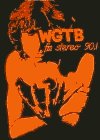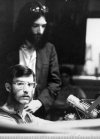
Washington
City Paper
Cover Story:
Radio Free
Georgetown
by Guy Raz
January 29
February 4
1999

|
|
RADIO FREE GEORGETOWN
WGTB came back on the air in the summer of '76, under new management: Robert Uttenweiler had been recruited from a station in Philadelphia that had experienced similar problems. He invited most of the ex-staffers back, but many stayed away. Friends, Sophie's Parlor, and Alternative News were off WGTB's air.
"Some of the controversial material will have to be studied further," Uttenweiler told the Washington Star at the time. "The gay material, for instance. The question is whether WGTB should be supporting homosexuality or the gay lifestyle. Well, we won't....The news will be changed, too...with no political slant."
The music programming was also regulated closely. WGTB started to broadcast Mass for Shut-Ins—a simulcast of the campus mass that allowed listeners who were bedridden an opportunity to tune in to worship services. Under Sleeman, the station had fiercely resisted the idea of broadcasting Mass.
Among those who returned, Music Director Paige was viewed as a sellout. "I was trying to encourage the old crowd back," he says. "Uttenweiler knew nothing about music. He was terrible, totally inappropriate." The music programmers, therefore, had to become more creative. Zappa was banned, but John Coltrane—equally subversive, equally radical—was acceptable.
"Before long, we were doing the same thing as before," says engineer Cullen. Leo del Aguila, another staffer who returned, still went by his old on-air persona, Professor Mota—Spanish slang for marijuana. And he still continued his on-air antics, often telling listeners about the "party in my pants."
And just as the late-'70s punk movement got under way, WGTB caught on, early enough to out-innovate any other station. Cerph Colwell, then a DJ at WHFS and now a host on WARW, concedes that his station didn't catch on to the rise of punk: "HFS completely missed the boat."
"From '76 to '79, the music really happened," says DJ Lorber. "It was really a DIY operation."
"GTB was one of the first stations in the country to play XTC, Pere Ubu, and glam rock," says Paige. So while the station was stripped of its politically radical edge, the music remained adventurous. And slowly, the political stuff crept back.
This time, Georgetown wasn't having any of it. The time had come to rid the university of what had become a serious nuisance. The simplest solution was to transfer the license over to UDC. Members of the staff formed the Alliance to Preserve Radio at Georgetown, but their attempts to block the transfer failed. On Jan. 29, 1979, WGTB slipped into oblivion.
Several days after the station went silent, the Cramps headlined a benefit show for WGTB at the Hall of Nations in Georgetown. Nearly 1,000 people showed up. "There was still some optimism that the [license] transfer wouldn't go through," recalls David Howcroft, the event's organizer.
Neither Howcroft nor the throng of fellow listeners who attended the benefit recognized at the time that the show would, years later, be remembered as a watershed in the harDCore music scene that was about to explode in the District.
The Cramps' lead singer, Lux Interior, stepped onstage and announced: "Some people wonder if this is a concert or a dance. Let me tell you, the concert just ended." With that, the crowd surged and lost control. "It was a sort of culmination," says Howcroft. "The last death throes of GTB. It was also the end of disco and the beginning of a whole new kind of music." WGTB's death coincided with the birth of Washington's art-house revolution—seeing through the rise of the Atlantis Club (later the 9:30 Club), d.c. space, and the Washington Project for the Arts.
|